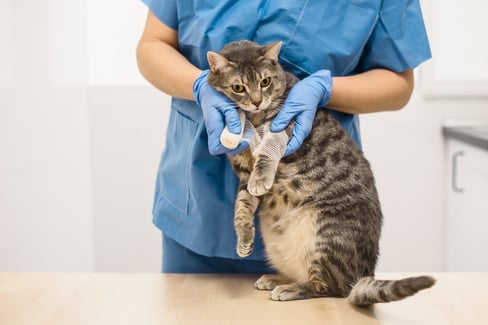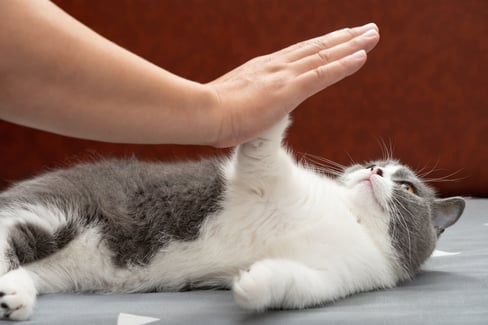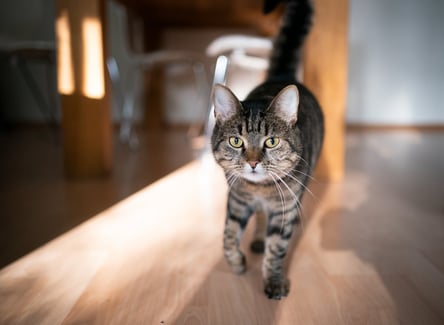Table of Contents
There’s nothing that hurts a cat owner’s heart quite like seeing their usually frisky kitty limping around on three paws. And not only does a cat paw injury make your fur baby feel miserable, but it can also put him at risk for some pretty nasty diseases.
While some cat paw injuries are mild, others can leave your kitty in deep water if you don’t tackle them fast. That’s why it’s so important to be prepared ahead of time and know what to do in the event that you spot your cat struggling with a hurt paw.
To help you do just that, we’ve put together this quick guide to everything you should know about a cat paw injury. We’ll go over causes, symptoms, injury types, and treatments you can provide to your dear kitty and make sure he’s back on his feet in no time!
Symptoms of Cat Paw Inflammation and Injury
A swollen cat paw is generally the first symptom of cat paw inflammation and injury. You might notice your pet wincing in pain when he tries to use his injured paw.
However, swollen paws aren’t the only things that can indicate your kitty is struggling. Aside from swelling, a few symptoms to watch out for include:
- Bleeding or redness of the cat’s paw pads
- Limping or refusing to use the injured paw
- Fluid discharge from the injured paw
- Excessive licking of the injured paw
- Wincing or meowing in pain when the injured paw is touched
Let’s go over these symptoms in a bit more detail.
Bleeding or Redness
Redness is a rare symptom of cat paw inflammation, except when a wound or a scratch accompanies the injury. Bleeding or redness can also happen when the cat neglects the pain he feels and still continues to use the injured paw.
As time progresses, the paw can start to bleed, which becomes even more detrimental for your kitty. Bleeding is a severe symptom of cat paw injury that calls for medical attention right away.
If you don’t treat it and act fast, that seemingly harmless bleeding can lead to infection, as bacteria will have easy access inside the body through the open wound.
Refusing to Use The Injured Paw
Humans avoid using their hands or feet when inflamed or injured. The same is true with cats. That’s why another common symptom of cat paw injury is when your cat is suddenly reluctant to use this paw. Cat limping is a major sign that your cat is suffering from an injury to his paw that needs to be treated immediately.
When cats stop using their paws regularly, the muscles in the injured paw might start to weaken and undergo atrophy. This leads to reduced mobility in your cat, leading to a lack of confidence (even when the injury heals) and even depression since your kitty doesn’t feel it can move around as much as it used to.
Possible Fluid Discharge
For more severe cat paw injuries, you could see a mild fluid discharge from the injured paw. This happens when the damage or the foot's landing is intense, which can also lead to contusion. Fluid discharge is one of the first signs that warrant a vet visit.
Excessive Cat Licking
When a cat is in pain, you may also notice it licking the involved area. It’s a way for cats to clean their wound and comfort themselves. When you see your cat doing this, it’s definitely time to give the vet a call.
Cat licking is never a good sign because the animal’s saliva can cause more harm than good. It can even lead to infection and delay the injured paw's healing.
Putting a stop to this kind of behavior often means putting a cone, onesie, or other accessory on your kitty to prevent him from licking the affected area.
Although he might not like it, this can help keep him from licking his paw and worsening an already uncomfortable situation. Still, it’s always best to speak to your vet in case there’s additional treatment needed (such as antibiotic cream or painkillers) beyond preventing your cat from licking his injury.
Wincing in Pain
When you get a bruise or injury to your hand, touching the area can lead to wincing. Cats experience the same issues.
If you hear your kitty meowing when he tries to put weight on his paw or when you touch his paw, it’s time to check for signs of inflammation or injury.
Sometimes, you might not even see any kind of injury. However, if your cat is in pain and showing you the signs, it’s a good idea to take him to the vet as soon as possible.
Cat Paw Injury Causes
There are tons of different reasons why your cat might be suffering from a hurt paw. These causes can also play a big role in how severe the injury is.
The reasons behind an inflamed or injured cat paw can range from trauma, mistaken landing, bug bites or stings, or nail overgrowth infections.
1. Trauma
Some of the most common causes include trauma to the paw because of scratches, abrasions, or cuts due to sharp objects. Blisters are also an indication of a possible burn. Trauma can also come from a foreign object getting stuck in the cat’s paw pad, causing injury.
Another type of trauma your cat could experience is breaking a toe after their claws snag on something and get pulled with force. The broken toe can lead to an injury of an entire paw or even a full-on cat sprained leg due to uncoordinated movement caused by pain.
Besides claws getting stuck on things, younger cats can also suffer trauma from playing with litter mates or other cats in the home. Cats play rough, often using their claws and teeth to bite and scratch one another.
Even though they’re just having fun, these actions can be traumatic to the animals, causing a possible inflammation or injury of the involved paws. If left untreated, these kinds of injuries, although minor at first, can cause bigger problems down the line.
Lastly, us owners can be suspects for cat paw trauma too. Because our kitty’s paws are so small, it can be easy to trip over Fluffy on your way to the bathroom at 4 am. Unfortunately, this is also a common cause of crushed toes and injured paws!
2. Stings and Bites from Insects
Although trauma encompasses many reasons why cats struggle with paw injuries, that’s far from the only cause.
Stings and bites from insects are other common reasons why you might notice cat paw inflammation. Cats are fond of swatting bees and insects. While that’s great for keeping the mosquitos out of the house, foes like hornets, wasps, or other stinging insects can sometimes have the last laugh in battle.
Stings and bites can quickly swell and lead to more severe infections if not treated immediately. There are also instances when the stinger will remain in the cat’s paw and will need to be carefully removed by a veterinarian.
A few other injuries that can occur thanks to insect stings and bites include
- Painful swelling
- Serious infection
- Tissues in the involved area dying
3. Allergic Reactions
Cats can also get allergic reactions, which can cause swollen paws, runny eyes, itching, feline digestive issues, runny nose, “hot spots” on their skin, and more. These animals can be allergic to various factors, such as food or things in their environment like dust, dirt, or grass.
Cats can also get allergic reactions from a bee sting or a bug bite. While these will often cause swelling and redness on their own, cats with allergies will have exaggerated forms of these reactions.
Take your cat to the vet if they show signs of
- Severe swelling
- Hives on any part of the body (your cat may roll around on a carpet or floor to itch the hives)
- Difficulty breathing
- Vomiting
- Diarrhea
- Excessive drooling (could be an indication that your cat has been stung on the mouth or in the throat)
- Signs of dizziness or disorientation
- Seizure
4. Sprain, Dislocations, Fracture
Cats love leaping from tall heights and clambering up and down furniture. However, all this leaping and romping around can potentially cause unfortunate consequences.
A few of these include
- Hairline bone fracture
- Dislocation
- Sprain
All these are because of a cat’s willingness to play, run, and jump. These can also occur when caretakers or pet owners accidentally step on the cat’s paws.
Regardless, the result is an injured paw and an unhappy cat.
5. Declawing and Ingrown Toenails
Ingrown claws can also be a cause of an inflamed paw. The claws can curl into the animal’s paw pad, causing the skin around it to be tender and in pain. This can also lead to inflammation and infection.
These types of injuries are especially common in senior cats than in kittens. Giving your cat supplements that contain key ingredients, such as glucosamine, can help prevent these issues from occurring as your kitty ages.
Besides aging, ingrown claws can also occur because of an underlying medical condition. You must see the vet immediately to rule out any serious issues if this is the case.
The other thing to think about is declawing. Declawing is harmful for cats and is banned in a number of states and provinces in the US and Canada.
There’s a good reason for that, too. Declawing can lead to nasty paw injuries, including paw necrosis and lameness. Since declawing changes the way that a cat’s paw hits the ground, it has a major impact on how your kitty walks, leading to a lot of discomfort for your fur baby. Instead of declawing, it’s best to use claw guards or just old-fashioned trimming!
6. Constriction
When a cat’s paws are constricted, they can also swell and become painful. Constriction can be caused by any object wrapped around the cat’s leg, like a rubber band (or hair tie), a string, or even a plastic bag. Monitoring what your cat is playing with when possible and placing potentially dangerous items out of reach is important to reduce the likelihood of injuries occurring.
Cat Paw Injury Types
There are several different types of cat paw injuries, although they usually occur in three places:
- Between the toes
- On the claw
- On the foot
Each type of injury will have almost the same symptoms and causes, so it’s best to have your vet by your side for a better diagnosis. Still, here are a few of the most common symptoms of each type of injury to help you get a feel for what the diagnosis might be.
|
Type of Cat Paw Injury |
Most Common Symptoms |
|
Between Toes |
|
|
Claw |
|
|
Foot |
|
Cat Paw Injury Between Toes
An injury between the toes of a cat’s paw can cause it to bleed or discharge pus. Another obvious symptom is the buildup of a crusty material between the toes. When not treated immediately, the injury can lead to severe infections that can affect the overall paw health of the cat.
Cat Claw Injury
A claw injury in a cat’s paw can lead to inactivity or lameness. It’s common for cats to keep their toenails regularly maintained by scratching them. This substitutes how the nails will naturally wear down in the wild.
A claw injury on a cat’s paw can lead to overgrown toenails, where painful infections can occur from various entry points. The injured claw will also often continue to grow while curling inwards toward the cat’s involved paw. This can be extremely painful, causing the cat to wince in pain and limp.
A cat’s claw injury can also lead to the formation of crust, splits, and growths around the tissues of the involved paw.
Cat Foot Injury
A cat foot injury usually leads to inactivity and lameness. This can cause your cat to start to lose muscle around the foot, making it harder for him to get back into his groove and run around as he used to, even after recovery.
Moreover, a cat foot injury can lead to different kinds of severe infections, especially when not treated immediately. As a result, it’s important to consult your vet to help properly treat your kitty early on.
Cat Paw Injury Treatment
Look for signs of swelling, soreness, blood, or other signs that your cat’s paw is what’s causing him pain.
Once you’ve determined that it’s definitely a cat paw injury you’re dealing with, it’s time to clean your cat’s paw. This is especially important when the injury involves scratches, cuts, or abrasions. To do this, gently lift the paw and clean the involved area using warm water.
Remember, be careful not to let your kitty lick the wound because this can lead to more infections. You may want to consider giving your cat a protective bootie or sock so that he won’t be able to lick the injury. Or, you could give him a collar or a cone to help discourage licking.
After cleaning the wound, it’s time to apply an antiseptic. Animal-safe antiseptic solutions can help speed up wound healing so that your cat will be back on all paws in no time. Antiseptics can also prevent bacterial infection by keeping the area clean.
Once you’ve taken these at-home steps, it’s always a good idea to head to the vet. The vet can perform tests, such as X-rays, which you can’t do at home, to help confirm the diagnosis and provide you with the right treatment.
Besides a visit to the vet, you can also support your pet’s recovery by giving him cat supplements for faster recovery. One such supplement that can help heal a cat paw injury is TRI-ACTA. This supplement helps to keep your cat’s muscles strong, prevent joint degeneration, and speed up the healing process.
TRI-ACTA H.A. for Pets
Our maximum strength formula is optimally designed to accelerate the formation of cartilage, minimize inflammation, expedite the healing process, and improve joint conditions.

All of this results in a cat that’s back to his rambunctious self in no time at all!
Summary
A cat’s paw injury should never be treated lightly. It’s a serious injury that can lead to various infections and more severe health issues. Moreover, a cat in pain can negatively affect its overall physical, emotional, and mental health.
The next time your cat experiences a paw injury from various causes, clean the wound and apply antiseptic right away. Be careful not to worsen the injury when taking your cat to the vet, and let your pet rest for a few weeks before allowing him to romp around again. That way, you should have him back to his normal self in no time!
Besides letting your pet rest and cleaning the cat paw injury, supplements like TRI-ACTA can also help keep your kitty feeling his best. These products contain the right ingredients to keep your cat’s muscles functional and his mobility high. Get in touch with our team or check out our FAQ to learn more about these supplements and how they can help!
Newsletter Signup
Subscribe to our newsletter to receive the latest news and exclusive offers.
.jpg?height=2000&name=Cliick_Integricare-DISPLAY-REVISEDV2%20(1).jpg)
Proactive & Therapeutic Joint Supplements
When given daily, Integricare joint supplements recover bone and joint injuries faster and help prevent mobility injuries from happening in the first place.










